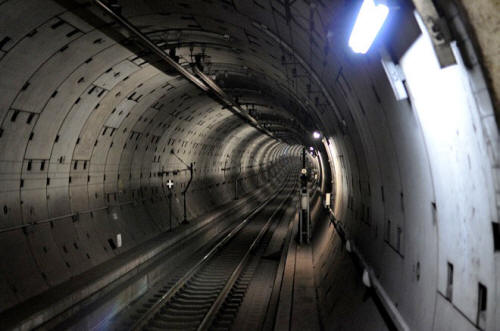|
from Wired Website
U.S. Air Force Considering Building Network of Tunnels
for Mobile Doomsday Trains.
This subway tunnel in Japan carries commuters. The Air Force is eying one that carries nukes. Photo: nappa/Flickr
The Air Force wants to upgrade its aging nuclear missiles and the hundreds of underground silos that hold them.
One idea it’s exploring: the construction of a sprawling network of underground subway tunnels to shuttle the missiles around like a mobile doomsday train. As one does.
As first reported by Inside Defense, the Air Force Nuclear Weapons Center will award several study contracts next month worth up to $3 million each to research the idea.
A broad agency announcement from the Air Force describes the hair-raising concept, intended to keep the weapons secure through 2075, as a system of tunnels where nuclear missiles are shuttled around on rails or some undefined “trackless” system.
The advantage of the world’s deadliest subway:
Missiles could be positioned at launch holes placed at “regular intervals” along the length of the tunnels.
The Air Force hasn’t given specifics on where the tunnels could be built, or how long they’d need to be.
The project would likely be gigantic, expensive and take decades to build - all things that cut against cut against these relatively lean times at the Pentagon.
But the U.S.’ silo-launched nuclear arsenal of 420 Minuteman III ballistic missiles are some of the oldest weapons still in service with the military, and they’re only getting older.
(Not to mention the upkeep the military has to perform on the other two legs of the nuclear triad, submarine-launched Trident II missiles and the air-dropped B61 nuclear weapon.)
The Air Force has spent billions upgrading the Minuteman’s guidance systems, rocket motors and power systems to keep them serviceable through 2030.
In a March 5 posture statement to the House Armed Services Committee, U.S. Strategic Command chief General Robert Kehler said the Minuteman IIIs are,
But to sustain the missiles until 2075, the service has to come up with new ideas.
The subway of doom isn’t the Air Force’s only option for revamping its silos. Others include “super-hardened” silos, or ground-based “transporter erector launchers” - really large trucks that can haul nuclear missiles around the country, including on public roads and even off-road.
The trucks have their downsides:
Last year, nuclear analyst Jeffrey Lewis estimated that building a fleet of 500 such mobile launchers would cost about $52 billion.
Lewis also noted that the mobile nuclear launchers were too expensive during the Cold War when, y’know, full-scale nuclear war was a big threat.
Hans Kristensen, a nuclear analyst at the Federation of American Scientists, thinks the Air Force is stuck with plain old static silos.
Then again, maybe the Air Force defies logic and builds the death tunnels that it says it wants.
Tomorrow’s Armageddon could ride to work on rails.
|

